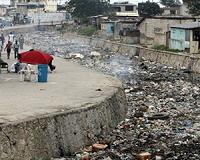| . |  |
. |
Canberra, Australia (SPX) May 03, 2010 Australian researchers describe a mathematical model in the International Journal of Operational Research that can find the ten optimal sites at which tsunami detection buoys and sea-level monitors should be installed. The model could save time and money in the installation of a detection system as well as providing warning for the maximum number of people should a potentially devastating tsunami occur again in the Indian Ocean. A magnitude 9.3 shook the sea floor off the coast of Aceh, in northern Sumatra, Indonesia, on 26 December 2004. The quake led to an overwhelming tsunami with waves as high as 10.5 m travelling at up to 8 m per second. Within two hours the tsunami had reached Colombo, in Sri Lanka and then the east coast of India. Almost eight hours later, fishing villages on the east coast of Africa in Kenya and Somalia felt its impact. There was no warning for the people affected and almost a quarter of a million lives were lost across eleven nations fringing the Indian Ocean. In 2005, the first steps to install a tsunami warning system in the Indian Ocean were being taken, with plans to deploy 24 tsunami detection buoys. The author of the study, Layna Groen and Lindsay Botten of the Department of Mathematical Sciences, at the University of Technology, and Katerina Blazek previously at Sinclair Knight Merz, in Sydney, NSW, Australia, suggest that their model has significant implications for the construction and maintenance of the tsunami warning system in the Indian Ocean. The Intergovernmental Oceanographic Commission (IOC) of the United Nations Educational, Scientific and Cultural Organisation (UNESCO) planned the establishment of the Indian Ocean Tsunami Warning and Mitigation System (IOTWS). The detection/alert system is the crucial component consisting of seismic detectors, sea-level monitors and deep-sea pressure sensors attached to deep ocean buoys. Groen and colleagues have focused on the latter two components as being critical to an adequate warning system. They point out that relatively few detection buoys are yet in place and a number of sea-level monitoring stations are still to be constructed. Their study, which uses the well-known modeling tool "Mathematica", should help the IOTWS decision makers in determining where the remaining buoys should be placed. The team's analysis supports the positioning of the 40 proposed buoys, but points out that just 1o buoys would be adequate for warning the maximum number of people. They add that the same mathematical modeling approach could be applied to tsunami detection in the Atlantic Ocean, the Mediterranean, Caribbean, and Black Seas. "The imperative for this is made clear in the UNESCO Intergovernmental Oceanographic Committee estimate that 'by the year 2025, three-quarters of the world's population will be living in coastal areas', and 'The expanded tsunami network that the Intergovernmental Oceanographic Commission of UNESCO is coordinating is just the first step in building a global tsunami warning system designed to monitor oceans and seas everywhere'."
Share This Article With Planet Earth
Related Links Intergovernmental Oceanographic Commission (IOC) Bringing Order To A World Of Disasters A world of storm and tempest When the Earth Quakes
 'Cash for work' program rebuilds Haiti, and its economy
'Cash for work' program rebuilds Haiti, and its economyLeogane, Haiti (AFP) April 30, 2010 Armed with rudimentary tools and often barefoot, dozens of Haitians work to reinforce river beds. The work is hard, but it brings in much-needed money and prepares the community for the rainy season. Along a stretch of riverbank almost a kilometer long, 10 teams of 20 people perform the same exhausting actions, turning over soil and extracting rocks under the boiling sun as they stand in mud ... read more |
|
| The content herein, unless otherwise known to be public domain, are Copyright 1995-2010 - SpaceDaily. AFP and UPI Wire Stories are copyright Agence France-Presse and United Press International. ESA Portal Reports are copyright European Space Agency. All NASA sourced material is public domain. Additional copyrights may apply in whole or part to other bona fide parties. Advertising does not imply endorsement,agreement or approval of any opinions, statements or information provided by SpaceDaily on any Web page published or hosted by SpaceDaily. Privacy Statement |